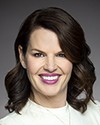Thank you, Madam Chair.
Committee members, thank you for having me here.
For 30 years, the Quebec Breast Cancer Foundation has been advocating for the interests and promoting the well‑being of breast cancer patients. The foundation makes a particularly significant contribution to medical and scientific advances, with investments in innovation and cutting‑edge research and in support, prevention and healing programs.
Every year, breast cancer accounts for around 1,380 deaths in Quebec. It remains the most common cancer in women. It's not only one of the most common cancers, it too often strikes the youngest people. Some 18% of diagnoses are made in women aged 50 and under. The increased number of cases in this age group has been documented.
It's widely acknowledged that screening plays a key role in reducing the mortality risk by 41%, for example.
As a result, we believe that it's vital to focus on the need for early detection in order to save even more lives.
Today, the committee is looking at screening age. The Quebec breast cancer screening program encourages women aged 50 to 74 to undergo screening mammography every two years. In recent months, the health minister has tasked the Institut national d'excellence en santé et en services sociaux with looking at the potential to expand the screening program to include people as young as 40. This is a welcome initiative.
However, it should be noted that the screening program focuses on a single risk factor, which is age. A program based solely on age assumes that all women in the same age category face the same level of risk. This isn't in line with the information available to science.
We now know that 12% of the population has more than a 10% risk of developing breast cancer before the age of 70. Approximately 50% of all breast cancers are diagnosed in women belonging to this sub‑population. In contrast, 50% of the population faces a breast cancer risk of 3% or less. In other words, breast cancer is concentrated in a relatively small portion of the female population.
Evidence suggests that other risk factors must be considered when determining each woman's risk profile. These factors include age, family history of cancer, DNA, breast density, Ashkenazi Jewish descent, hormone exposure, alcohol consumption, height and body mass index. This shows the need to move towards more preventive and personalized medicine.
As a result, the foundation would like to see governments transition from an age‑based to a risk‑based approach to screening.
With this in mind, the foundation was the first to provide funding for PERSPECTIVE, an innovative project that assessed a new screening strategy based on each individual's unique risk profile. The project led to the development of a saliva test that, combined with a questionnaire, calculates a woman's risk of breast cancer. This makes it possible to carry out customized screening and promotes early detection of the disease. The integration of this innovative approach would modernize breast cancer screening and would have many social and economic benefits.
There would be multiple benefits for patients. These benefits include earlier detection, which significantly affects the choice of treatment; higher survival rates; improved quality of life; better patient experiences; less stress from excessive screening; and a lower psychosocial impact.
The benefits for the health care system are just as significant. These benefits include more effective use of human and technical resources; improved clinical performance; better quality of care; and lower health care and social costs.
We also know that the socio‑economic burden of breast cancer is significant in Quebec and the rest of Canada. In specific terms, the average cost of care required for breast cancer treatment varies according to the stage. The earlier the cancer is detected, the lower the health care costs. In Ontario, the treatment for a cancer in situ costs around $14,000, while the treatment for stage 4 cancer costs around $370,000. This amounts to a difference of almost $350,000. Early detection is important. It could both save lives and lower costs.
Now that the PERSPECTIVE project has come to fruition, the foundation wants to help modernize breast cancer screening methods by integrating this innovation into standard health care practices.
We want governments to get on board with this new perspective, which aligns with science and which would have a major impact. Let's do this for women, for survivors, for daughters, for spouses and for mothers, too many of whom are still living with cancer.



